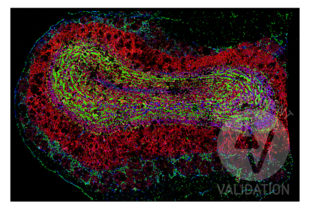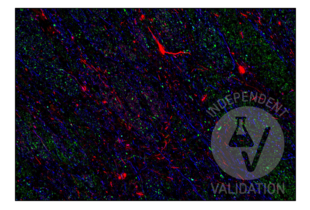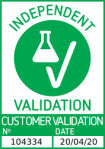Cortactin antibody (N-Term)
-
- Target See all Cortactin (CTTN) Antibodies
- Cortactin (CTTN)
-
Binding Specificity
- N-Term
-
Reactivity
- Human
-
Host
- Rabbit
-
Clonality
- Polyclonal
-
Conjugate
- This Cortactin antibody is un-conjugated
-
Application
- Western Blotting (WB), Immunofluorescence (IF), Immunohistochemistry (Paraffin-embedded Sections) (IHC (p)), Immunocytochemistry (ICC)
- Cross-Reactivity
- Human, Mouse, Rat
- Characteristics
-
Rabbit Polyclonal antibody to Cortactin (src substrate cortactin)
Cortactin antibody [N1], N-term - Purification
- Purified by antigen-affinity chromatography.
- Grade
- KO Validated
- Immunogen
- Carrier-protein conjugated synthetic peptide encompassing a sequence within the N-terminus region of human Cortactin. The exact sequence is proprietary.
- Isotype
- IgG
-
-
- Application Notes
- WB: 1:500-1:3000. ICC/IF: 1:100-1:1000. IHC-P: 1:100-1:1000. Optimal dilutions/concentrations should be determined by the researcher. Not tested in other applications.
- Comment
-
Positive Control: NIH-3T3 , JC , PC-12 , mouse brain , rat brain , HeLa
Validation: KO/KD
- Restrictions
- For Research Use only
-
- by
- Akoya Biosciences
- No.
- #104334
- Date
- 04/20/2021
- Antigen
- Cortactin
- Lot Number
- 39568
- Method validated
- Multiplex Immunohistochemistry
- Positive Control
Fresh frozen mouse olfactory bulb
- Negative Control
Unlabeled control (mouse fresh frozen)
- Notes
Passed. The anti-cortactin antibody ABIN2854674 produces high degrees of labeling in granular and external plexiform layers of the mouse olfactory bulb. Additional labeling can be observed in the neuropil of individual glomeruli which is consistent with staining of synapses and neuronal processes.
- Primary Antibody
- ABIN2854674
- Secondary Antibody
- Full Protocol
- Protocol details are described in the Akoya Biosciences CODEX® User Manual (see https://www.akoyabio.com/wp-content/uploads/2021/01/CODEX-User-Manual.pdf).
- Tissue preparation as outlined in the Akoya Biosciences CODEX® User Manual fresh-frozen tissue protocol.
- Conjugation of the anti-cortactin ABIN2854674 antibody to an oligo barcode used to bind oligo-conjugated fluorophore ATTO 550.
- Experimental Notes
No signal was detected in unlabeled specimens.
Specific staining of Cortactin was also observed with human FFPE cortical tissue sections with both citrate antigen retrieval and EDTA antigen retrieval.
Optimal staining and signal to noise ratios were obtained if tissue was pre-treated for autofluorescence removal (see https://www.akoyabio.com/wp-content/uploads/2020/07/Customer-Demonstrated-Protocol-Autofluorescence-Quenching-Mar2020.pdf).
Validation #104334 (Multiplex Immunohistochemistry)![Successfully validated 'Independent Validation' Badge]()
![Successfully validated 'Independent Validation' Badge]() Validation Images
Validation Images![Murine fresh frozen coronal olfactory bulb section (Thickness = 5 µm) labeled with anti-cortactin antibody ABIN2854674 (green; conjugated to fluorophore ATTO 550). Labeling is present in high degrees of labeling in granular and external plexiform layers with additional staining observed in the glomerular neuropil regions. Grin2b and doublecortin were labeled with ABIN5611338 (red; bound to fluorophore ATTO 550) and a doublecortin antibody (blue; bound to fluorophore AF 488).]() Murine fresh frozen coronal olfactory bulb section (Thickness = 5 µm) labeled with anti-cortactin antibody ABIN2854674 (green; conjugated to fluorophore ATTO 550). Labeling is present in high degrees of labeling in granular and external plexiform layers with additional staining observed in the glomerular neuropil regions. Grin2b and doublecortin were labeled with ABIN5611338 (red; bound to fluorophore ATTO 550) and a doublecortin antibody (blue; bound to fluorophore AF 488).
Murine fresh frozen coronal olfactory bulb section (Thickness = 5 µm) labeled with anti-cortactin antibody ABIN2854674 (green; conjugated to fluorophore ATTO 550). Labeling is present in high degrees of labeling in granular and external plexiform layers with additional staining observed in the glomerular neuropil regions. Grin2b and doublecortin were labeled with ABIN5611338 (red; bound to fluorophore ATTO 550) and a doublecortin antibody (blue; bound to fluorophore AF 488).
![FFPE normal human cortex tissue section labeled with anti-cortactin antibody ABIN2854674 (green; bound to fluorophore ATTO 550) after EDTA antigen retrieval. MAP2 and neurofilament were additionally labeled with anti-MAP2 antibody ABIN125739 (red; bound to fluorophore ATTO 550) and anti-neurofilament antibody (blue; bound to fluorophore AF488).]() FFPE normal human cortex tissue section labeled with anti-cortactin antibody ABIN2854674 (green; bound to fluorophore ATTO 550) after EDTA antigen retrieval. MAP2 and neurofilament were additionally labeled with anti-MAP2 antibody ABIN125739 (red; bound to fluorophore ATTO 550) and anti-neurofilament antibody (blue; bound to fluorophore AF488).
Full Methods
FFPE normal human cortex tissue section labeled with anti-cortactin antibody ABIN2854674 (green; bound to fluorophore ATTO 550) after EDTA antigen retrieval. MAP2 and neurofilament were additionally labeled with anti-MAP2 antibody ABIN125739 (red; bound to fluorophore ATTO 550) and anti-neurofilament antibody (blue; bound to fluorophore AF488).
Full Methods -
- Format
- Liquid
- Concentration
- 1 mg/mL
- Buffer
- 1XPBS ( pH 7), 20 % Glycerol, 0.025 % ProClin 300
- Preservative
- ProClin
- Precaution of Use
- This product contains ProClin: a POISONOUS AND HAZARDOUS SUBSTANCE which should be handled by trained staff only.
- Storage
- 4 °C,-20 °C
- Storage Comment
- Store as concentrated solution. Centrifuge briefly prior to opening vial. For short-term storage (1-2 weeks), store at 4°C. For long-term storage, aliquot and store at -20°C or below. Avoid multiple freeze-thaw cycles.
-
- Target
- Cortactin (CTTN)
- Alternative Name
- cortactin (CTTN Products)
- Background
-
This gene is overexpressed in breast cancer and squamous cell carcinomas of the head and neck. The encoded protein is localized in the cytoplasm and in areas of the cell-substratum contacts. This gene has two roles: (1) regulating the interactions between components of adherens-type junctions and (2) organizing the cytoskeleton and cell adhesion structures of epithelia and carcinoma cells. During apoptosis, the encoded protein is degraded in a caspase-dependent manner. The aberrant regulation of this gene contributes to tumor cell invasion and metastasis. Two splice variants that encode different isoforms have been identified for this gene.
Cellular Localization: Cytoplasm , cytoskeleton (By similarity) , Cell projection , lamellipodium (By similarity) , ruffle (By similarity) - Molecular Weight
- 62 kDa
- Gene ID
- 2017
- UniProt
- Q14247
- Pathways
- MAPK Signaling
-



 (1 validation)
(1 validation)



